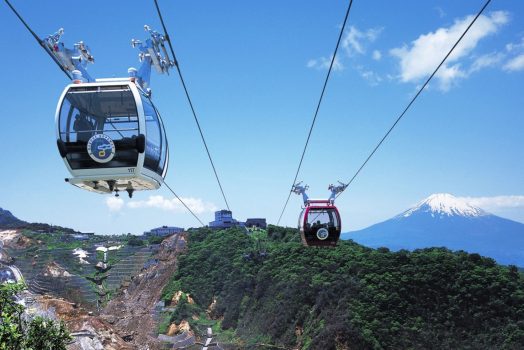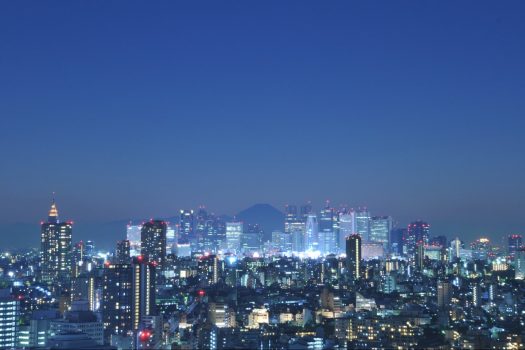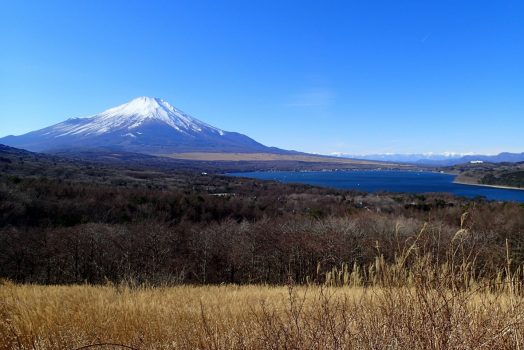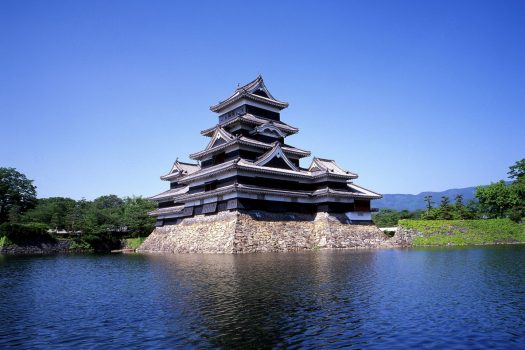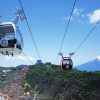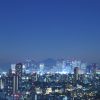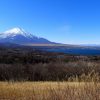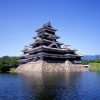Japan: The Historic Route
Japan represents the perfect merger of the ancient and the contemporary. The tour starts in Tokyo, Japan’s capital. After visiting a variety of Tokyo’s districts, the tour continues to Mt. Fuji. Although it is an active volcano, there hasn’t been an eruption since 1708. The perfectly shaped volcano can be seen from Tokyo on clear days and is worshipped by the Japanese. The tour continues to Mt. Hakone, which is famous for hot springs, natural beauty and the view of nearby Mt. Fuji. Hakone is one of the most popular destinations among Japanese and will sure amaze international visitors as well!
The next stop of the tour is at Matsumoto, where you will have the chance to admire the famous Matsumoto castle. Your visit will continue at Takayama’s old town, with many buildings and whole streets of houses dating from the Edo Period (1600-1868). The tour continues to Shirakawago, a UNESCO world heritage site, famous for its traditional gassho-zukuri farmhouses. The next stop is at the Omicho Market, which has been Kanazawa’s largest fresh food market since the Edo Period. The tour also includes a visit of Kanazawa’s unchallenged main attraction: Kenrokuen, one of Japan’s “three best landscape gardens”.
The tour continues to Kyoto, which was destroyed by many wars and fires. However, countless temples, shrines and other historically priceless structures survive in the city today. Near Kyoto you will visit Fushimi Inari Shrine, a Shinto shrine and Kiyomizudera, one of the most celebrated temples of Japan. Furthermore you will discover Kinkakuji, which is a Zen temple whose top two floors are completely covered in gold leaf. The tour ends with a train ride back to Tokyo on the famous shinkansen, a train running 320km/h.
Dates
Dates on request
Suggested Itinerary by Air
Day 1-2
Arrive in Tokyo
Travel from London Heathrow or your regional airport to Tokyo. You are met on arrival at the airport before being transferred to your hotel. Enjoy the rest of the day at leisure.
Day 3
Tokyo
In the morning you will visit Asakusa, one of Tokyo’s districts, where an atmosphere of the Tokyo of past decades survives. Asakusa’s main attraction is Sensoji, a very popular Buddhist temple, built in the 7th century. The temple is approached via the Nakamise, a shopping street that has been providing temple visitors with a variety of traditional, local snacks and tourist souvenirs for centuries. The visit is followed by a sushi making experience for lunch.
In the afternoon, you will visit the Ginza, Tokyo’s most famous upmarket shopping, dining and entertainment district, featuring numerous department stores, boutiques, art galleries, restaurants, night clubs and cafes. It is followed by The Imperial Palace East Gardens that are a part of the inner palace area. They are the former site of Edo Castle’s innermost circles of defense, the honmaru (“main circle”) and ninomaru (“secondary circle”). None of the main buildings remain today, but the moats, walls, entrance gates and several guardhouses still exist. The visit will finish with Akihabara, also called Akiba, which is a district in central Tokyo that is famous for its many electronics shops. In more recent years, Akihabara has gained recognition as the center of Japan’s Otaku culture, and many shops and establishments devoted to anime and manga are now dispersed among the electronic stores in the district.
Day 4
Mt. Fuji & Hakone
After breakfast you will visit Mount Fuji, which at 3776 metres, is Japan’s highest mountain. It is not surprising that the nearly perfectly shaped volcano has been worshiped as a sacred mountain and experienced a huge popularity among artists and common people throughout the centuries. Mount Fuji is an active volcano, which last erupted in 1708 and can be seen from Tokyo and Yokohama on clear days.
You will travel through Owakudani, which is the area around a crater created during the last eruption of Mount Hakone some 3000 years ago. Today, much of the area is an active volcanic zone where sulfurous fumes, hot springs and hot rivers can be experienced. Additionally, Owakudani has good views of Mount Fuji on clear days. You will continue your journey to Hakone Town via Lake Ashi, which is today with Mount Fuji in the background, the symbol of Hakone. Hakone is part of the Fuji-Hakone-Izu National Park, less than 100 kilometers from Tokyo. Famous for hot springs, natural beauty and the view of nearby Mt. Fuji, Hakone is one of the most popular destinations among Japanese and international tourists looking for a break from Tokyo. Return to Tokyo in the afternoon.
Day 5
Tokyo – Matsumoto – Takayama
Today you will check out of the hotel in the morning and transfer to Matsumoto, which is most famous for Matsumotojo, one of Japan’s most beautiful and original castles. Matsumoto Castle is one of the most complete and beautiful among Japan’s original castles. It is a “hirajiro” – a castle built on plains rather than on a hill or mountain. Matsumoto Castle is unique for having both a secondary donjon and a turret adjoined to its main keep. The castle structures, in combination with their characteristic black wainscoting, give off an air of grandeur and poise. In the afternoon you will transfer to Takayama and have the rest of the day at leisure.
Day 6
Takayama
This morning you will visit Takayama, which retains a traditional touch like few other Japanese cities, especially in its beautifully preserved old town. You will start the visit with the Miyagawa Market along the Miyagawa River in the old town with most stands selling local crafts, snacks and farm products such as vegetables, pickles and flowers. Your visit continues with Takayama’s old town, which has been beautifully preserved with many buildings and whole streets of houses dating from the Edo Period (1600-1868), when the city thrived as a wealthy town of merchants. The southern half of the old town, especially the Sannomachi Street, survives in a particularly pretty state with many old homes, shops, coffee houses and sake breweries, some of which have been in business for centuries.
You will then visit the Takayama Jinya, which served as the local government office headed by the officials dispatched from Edo (present day Tokyo). The building complex was in official use until 1969, and is now open to the public as a museum. It includes various nicely maintained tatami mat rooms that once served as offices, conference rooms, guest rooms and residential space. There is also an interesting interrogation room. Beside the main building stands a large storehouse built in the 1600s. Known as the biggest traditional rice storehouse in Japan, it now functions as a museum, showcasing belongings and official documents of past feudal lords, old maps of the Hida Region and historic town plans. Enjoy the rest of the day to discover the rest of Takayama on your own.
Day 7
Takayama – Shirakawago – Kanazawa
In the morning, check out of the hotel and transfer to Shirakawago. Declared a UNESCO world heritage site in 1995, it is famous for its traditional gassho-zukuri farmhouses, some of which are more than 250 years old. The architectural style developed over many generations and is designed to withstand the large amounts of heavy snow that falls in the region during winter. The roofs, made without nails, provided a large attic space used for cultivating silkworms.
In the afternoon you will transfer to Kanazawa, which during the Edo Period, served as the seat of the Maeda Clan, the second most powerful feudal clan after the Tokugawa in terms of rice production and fief size. Accordingly, Kanazawa grew to become a town of great cultural achievements, rivalling Kyoto and Edo (Tokyo). Your visit will start with the Higashi Chaya District. A chaya (lit. teahouse) is an exclusive type of restaurant where guests are entertained by geisha who perform song and dance. During the Edo Period, chaya were found in designated entertainment districts, usually just outside the city limits. Kanazawa has three, well preserved chaya districts, Higashi Chayagai (Eastern Chaya District), Nishi Chayagai (Western Chaya District) and Kazuemachi. Of the three districts, the Higashi Chaya District is the largest and by far the most interesting. Two chaya, the Shima Teahouse and Kaikaro Teahouse, are open to the public. Other buildings along the central street now house cafes and shops.
Your visit will continue with the Omicho Market, which has been Kanazawa’s largest fresh food market since the Edo Period. Today, it is a busy and colorful network of covered streets lined by about 200 shops and stalls. While most shops specialise in the excellent local seafood and produce, you can also find flowers, clothing, kitchen tools and more on sale. Finally you will visit Nagamachi, which was a samurai district located at the foot of the former Kanazawa Castle, where samurai and their families used to reside. The area preserves a historic atmosphere with its remaining samurai residences, earthen walls, private entrance gates, narrow lanes and water canals.
Day 8
Kanazawa – Kyoto
Following breakfast you will check out of the hotel and visit Kanazawa’s unchallenged main attraction: Kenrokuen, one of Japan’s “three best landscape gardens” and by many considered the most beautiful of them all. The spacious grounds used to be the outer garden of Kanazawa Castle and were constructed by the ruling Maeda family over a period of nearly two centuries. Opened to the public in 1871, Kenrokuen features a variety of flowering trees which provide the garden with a different look for each season. Following lunch you will transfer to Kyoto and check in at the hotel. Over the centuries, Kyoto was destroyed by many wars and fires, but due to its historic value, the city was dropped from the list of target cities for the atomic bomb and spared from air raids during World War II. Countless temples, shrines and other historically priceless structures survive in the city today. In the evening, you will enjoy a Geisha dance performance followed by dinner in a local restaurant.
Day 9
Kyoto
After breakfast you will have a guided tour of the Japanese Imperial City. You will start with the Fushimi Inari Shrine, an important Shinto shrine in southern Kyoto. It is famous for its thousands of vermilion torii gates, which straddle a network of trails behind its main buildings. The trails lead into the wooded forest of the sacred Mount Inari, which stands at 233 meters and belongs to the shrine grounds. Fushimi Inari is the most important of several thousands of shrines dedicated to Inari, the Shinto god of rice. Foxes are thought to be Inari’s messengers, resulting in many fox statues across the shrine grounds. Fushimi Inari Shrine has ancient origins, predating the capital’s move to Kyoto in 794.
You will then visit Kiyomizudera, one of the most celebrated temples of Japan. It was founded in 780 on the site of the Otowa Waterfall in the wooded hills east of Kyoto, and derives its name from the fall’s pure waters. The temple was originally associated with the Hosso sect, one of the oldest schools within Japanese Buddhism, but formed its own Kita Hosso sect in 1965. In 1994, the temple was added to the list of UNESCO world heritage sites.
In the afternoon you will discover Kinkakuji, which is a Zen temple whose top two floors are completely covered in gold leaf. Kinkakuji is an impressive structure built overlooking a large pond, and is the only building left of Yoshimitsu’s former retirement complex. It has burned down numerous times throughout its history and the present structure was rebuilt in 1955. Continuing your journey around Kyoto, you will visit Gion, which is Kyoto’s most famous geisha district. It is filled with shops, restaurants and ochaya (teahouses), where geiko (Kyoto dialect for geisha) and maiko (geiko apprentices) entertain.
Finally, you will conclude your day at the Nishiki Market, which is a narrow, five block long shopping street lined by more than one hundred shops and restaurants. Known as “Kyoto’s Kitchen”, this lively retail market specialises in all things food related, like fresh seafood, produce, knives and cookware, and is a great place to find seasonal foods and Kyoto specialties, such as Japanese sweets, pickles, dried seafood and sushi.
Day 10
Kyoto – Tokyo
After breakfast you will have the morning at leisure to discover the rest of Kyoto on your own. Following lunch you will transfer to Tokyo using the famous shinkansen train. Running at speeds of up to 320 km/h, the shinkansen is known for punctuality, comfort, safety and efficiency. Upon your arrival in Tokyo, you will check in at your hotel and have the remaining of the day at leisure. Enjoy the last few hours in the Japanese capital for some last minute shopping and sightseeing.
Day 11
Farewell from Japan
After breakfast you will be transferred from the hotel to the airport for your flight back to London Heathrow or your regional airport.
Despite frequent showers, Spring is one of the most pleasant times to visit Japan, when the weather reports chart the steady progress of the cherry blossom from warm Kyūshū in March to colder Hokkaidō around May. A rainy season (tsuyu) during June ushers in the swamp-like heat of summer; if you don’t like tropical conditions, head for the cooler hills or the northern reaches of the country. A bout of typhoons and more rain in September precede autumn, which lasts from October to late November; this is Japan’s most spectacular season, when the maple trees explode into a range of brilliant colours. Also worth bearing in mind when thinking about the best time to visit are Japan’s national holidays. During such periods, including the days around New Year, the “Golden Week” break of April 29 to May 5 and the Obon holiday of mid-August, the nation is on the move, making it difficult to secure last-minute transport and hotel bookings. Avoid travelling during these dates, or make your arrangements well in advance.



